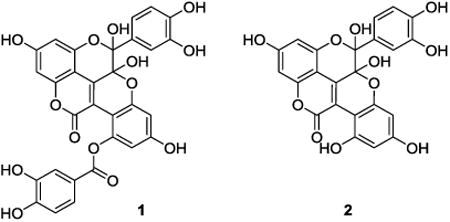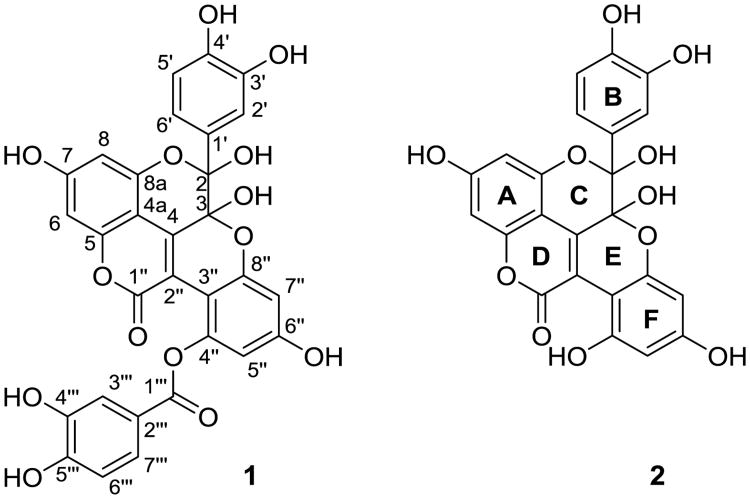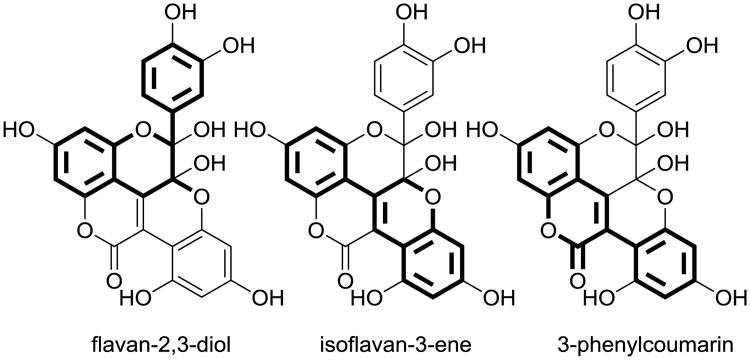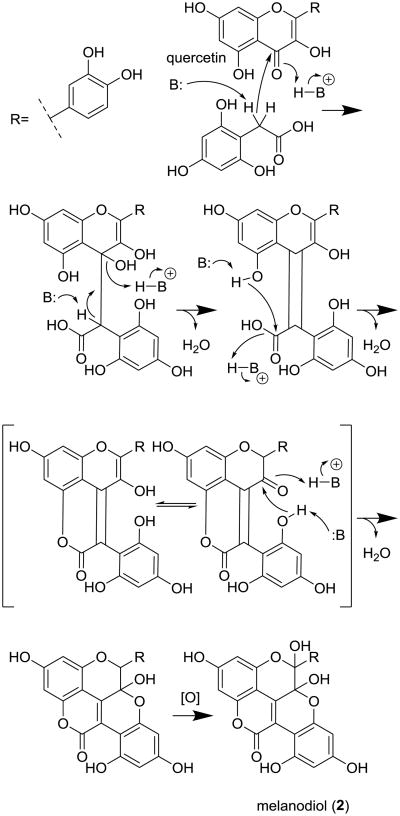Abstract
Melanodiol 4″-O-protocatechuate (1) and melanodiol (2) represent novel flavonoid derivatives isolated from a botanical dietary supplement ingredient, dried black chokeberry (Aronia melanocarpa) fruit juice. These non-crystalline compounds possess an unprecedented fused pentacyclic core with two contiguous hemiketals. Due to having significant hydrogen deficiency indices, their structures were determined using computer-assisted structure elucidation software. The in vitro hydroxyl radical-scavenging and quinone reductase-inducing activity of each compound are reported, and a plausible biogenetic scheme is proposed
Graphical abstract

Black chokeberry [Aronia melanocarpa (Michx.) Elliott (Rosaceae)] has become a popular “superfruit” and botanical dietary supplement ingredient in the United States and some European countries.1 Several recent in vivo studies have shown evidence that Aronia extracts may reduce the risk of metabolic syndrome or cardiovascular disease, and various other potential health benefits have been noted.2–4 Accordingly, the measured antioxidant potential and detailed phytochemical investigations of this plant material were recently reported.5,6 In the preceding in vitro hydroxyl radical-scavenging and quinone reductase (QR) inducing bioactivity-guided study conducted by some members of our group,5 an initially uncharacterized compound {1; 3.5 mg; 0.0002% w/w yield; [α]20D 0 (c 0.1, MeOH)} was isolated as a yellow-green amorphous solid from 2 kg of spray-dried black chokeberry fruit juice that could not then be structurally determined using available and conventional methods. This resulted from the observation of a significant hydrogen deficiency index for the compound, since its molecular formula was determined to be C30H18O14 [m/z 625.0574 (M + Na)+ (calcd for C30H18O14Na, 625.0594)] by HRESIMS. Furthermore, a lack of data attainable in NMR experiments, such as long-range 1H-13C HMBC correlations, precluded complete structural elucidation. The attempted re-isolation of 1 instead yielded a structural analogue, 2. Figure 1 shows the structures of two novel flavonoid derivatives from A. melanocarpa fruit juice extract that share an unprecedented fused pentacyclic core skeleton containing two contiguous hemiketals, and herein described are their isolation, structure elucidation, and biological activities observed for each, as is a proposed biogenetic pathway.
Figure 1.
Structures of 1 and 2 with preferred atom numbering and ring abbreviations.
Computer-assisted structure elucidation (CASE) is a technological development made in recent years to overcome obstacles in data interpretation such as that described above, and has further been utilized to revise some published structures associated with misinterpreted data sets.7–9 The CASE software is used to generate and then filter through numerous permutations of structures that are theoretically possible in an unbiased way, which could correspond to a given dataset. The data collected for 1 were analyzed initially using the ACD/Labs Structure Elucidator (Struc_Eluc; ACD/Labs, Toronto, ON, Canada). Struc Eluc generated 176400 isomers and 42 molecules passed the filter in a generation time of: 23 seconds. Based on the 1H NMR data, two substructures of benzene-1,2-diol fragments were added to speed up the generation time. Struc_Eluc suggested a feasible structure for compound 1 that could be neither confirmed nor discounted without further experimentation due to the need to determine the linkage position of the protocatechuic acid ester moiety, for which direct evidence was lacking. Additional experiments were not possible to conduct with the amount of material then available from the previous study.
The 1H NMR spectrum of 1 was taken in MeOD and only displayed ten non-labile protons, all of which are in the aromatic region. A few fragments could be determined from 2D 1H homonuclear together with 2D heteronuclear, such as 1H-13C HSQC and 1H-13C HMBC, NMR experiments. The 1H NMR spectrum later obtained in DMSO-d6 was further suggestive of eight hydroxy groups, of which two were observed as sharp singlets (δH 7.66 and 7.47 ppm) with strong cross-peaks in the 1H-13C HMBC experiment. The additional information garnered from the 1H-13C HMBC spectrum with respect to the sharp hydroxy protons suggested the main molecular fragment of a flavonoid with a typical catechol moiety in the C-ring, but with the notable point that C-3 showed a shift of δC 93.5 ppm that was indicative of di-oxygenated substitution while the quaternary carbon C-4 retained an appropriate shift for a vinylic carbon at δC 137.7 ppm. Together, this implied that the core of the molecule is a flavan-2,3-diol with vinylic unsaturation at the C-4 position and not a flavon-2,3-diol with C-4 carbonyl functionality. The 1H NMR spectrum of 1 in DMSO-d6 also contained the added complexity of two sets of overlapping proton peaks at the highest field (δH 6.28-6.38 ppm), corresponding to two fragments of 1,3,5-trioxygenated phenyl groups, of which one was identified as belonging to the A-ring of the flavan-2,3-diol core with a typical shift for hydroxylated C-7 at δC 163.3 ppm. Examination of the 1H NMR spectrum recorded in MeOD, showed that all four high-field aromatic protons were clearly resolved, but the next two highest field doublet protons (δH 6.78 and 6.86 ppm in DMSO-d6, J = 8.3 Hz) collapsed to a perfectly overlapped pair of doublets (δH 6.89 ppm in MeOD, J = 8.3 Hz) corresponding to the ortho-coupled protons at C-5′ and C-6‴ of two phenyl groups each with a 1,3,4 protonation pattern and 5,6-dioxygenated functionality. Despite exhaustive efforts, however, including 1D selective NOESY experiments on a high-field (1H 800 MHz) NMR spectrometer, in each MeOD and DMSO-d6, the connectivity of the central core and protocatechuic acid ester group could not be established due to the paucity of correlations between these fragments.
An attempt to re-isolate compound 1 by silica gel and LH-20 column chromatography followed by preparative RP-HPLC ultimately resulted, instead, in the isolation of the simpler structural analogue, melanodiol {2; 3.0 mg; 0.0003% w/w yield [α]20D 0 (c 0.1, MeOH)}. Compound 2 was obtained as a yellow-green amorphous solid. Analysis of the NMR and HRESIMS data obtained for 2 indicated its molecular formula to be C23H14O11 [m/z 467.0626 (M + H)+ (calcd for C23H15O11, 467.0614)] and that the difference between 2 and 1 was absence of the protocatechuic acid ester unit not assigned to a specific position previously in 1. This protocatechuic acid ester group furthermore represented the only notable fragmentation peak (-136) in the ESIMS/MS of 1. The 1H NMR spectrum of 2 recorded in DMSO-d6 displayed seven aromatic protons and several hydroxy groups, of which three could be clearly distinguished and were sharp enough singlets to show cross peaks in the HMBC experiment. Key HMBC correlations for 1 and 2 are shown in Figure 2. The splitting patterns of those aromatic protons in 2 showing carbon linkages in the HSQC experiment followed those observed for 1, containing two sets of meta-coupled phenyl protons but only one 1,3,4-protonated and 5,6-dioxygenated ring system, again corroborating the lack of a protocatechuic acid ester moiety. Struc_Eluc also used the NMR data with the three aromatic rings A, B, and F and filtered through over one million generated structural isomers to yield the top hit as compound 2.
Figure 2.
Selected HMBC correlations observed for 1 and 2.
A comparison of the 1H and 13C NMR data collected for 1 and 2 in the same solvent and at the same temperature (Tables 1 and 2, respectively) allowed for the final assignment of the position of the protocatechuic acid ester in 1 to C-4″, which was equivalent with the highest ranked suggestion from Struc_Eluc. The sharp singlet observed for OH-4″ (δH 11.14 ppm) in 2 but not 1 was attributed to the formation of an intramolecular hydrogen bond with the carbonyl oxygen at C-1″, and has rational implications for the chemical shifts of nearby carbons when compared to the substitution with a protocatechuic acid ester moiety. Finally, the nearly equivalent deshielding observed for H-3‴ and H-7‴ in 1 might be understood as resulting from similar spatial proximities to the two carbonyl oxygens of C-1″ and C-1‴.
Table 1.
1H NMR (400 MHz, 300 K, DMSO-d6) Spectroscopic Data for 1 and 2.
| δHppm (J, Hz) | ||
|---|---|---|
| position | 1 | 2 |
| 6 | 6.31 ma | 6.52, d (1.5) |
| 8 | 6.31 ma | 6.40, d (1.5) |
| 2′ | 7.26 d (2.1) | 7.23, d (2.1) |
| 5′ | 6.79 d (8.3) | 6.78, d (8.3) |
| 6′ | 7.06 dd (8.3, 2.1) | 7.04, dd (8.3, 2.1) |
| 2-OH | 7.66 s | 7.64 |
| 3-OH | 7.47 s | 7.45 |
| 5″ | 6.36 ma | 5.98, d (2.5) |
| 7″ | 6.36 ma | 5.90, d (2.5) |
| 4″-OH | 11.14 | |
| 3‴ | 7.43 dd (8.3, 1.8) | |
| 6‴ | 6.87 d (8.3) | |
| 7‴ | 7.41 d (1.8) | |
Signal partially overlapped
Table 2.
13C NMR Spectroscopic Data (100 MHz, 300 K, DMSO-d6) for 1 and 2.
| δCppm | δCppm | ||||
|---|---|---|---|---|---|
| position | 1 | 2 | position | 1 | 2 |
| 2 | 102.4 | 101.9 | 1″ | 158.9 | 163.4 |
| 3 | 93.5 | 92.3 | 2″ | 107.3 | 108.4 |
| 4 | 137.7 | 137.7 | 3″ | 104.6 | 98.2 |
| 4a | 98.8 | 98.9 | 4″ | 148.5 | 155.8 |
| 5 | 153.3 | 153.1 | 5″ | 106.8 | 99.8 |
| 6 | 103.3 | 95.7 | 6″ | 157.5 | 159.9 |
| 7 | 163.3 | 163.8 | 7″ | 95.9 | 98.3 |
| 8 | 102.1 | 102.0 | 8″ | 154.6 | 152.9 |
| 8a | 152.9 | 152.6 | 1‴ | 164.6 | |
| 1′ | 129.3 | 128.9 | 2‴ | 121.5 | |
| 2′ | 117.5 | 117.1 | 3‴ | 117.6 | |
| 3′ | 144.8 | 144.3 | 4‴ | 145.9 | |
| 4′ | 146.7 | 146.3 | 5‴ | 151.6 | |
| 5′ | 115.0 | 114.6 | 6‴ | 116.2 | |
| 6′ | 120.8 | 120.4 | 7‴ | 123.3 | |
The 1H to 13C and other heavy atoms ratios for compounds 1 and 2 were found to be 18:44 and 14:34, respectively, and these fell considerably below the 2:1 ratio that has been suggested anecdotally for straightforward structure elucidation. Due to the complexity of the central core, one could envision these compounds as belonging to either of the flavan (rings A, B, and C) or isoflavan-3-ene (rings A, E, and F) classes of flavonoids or the 3-phenylcoumarin (rings A, D, and F) family of natural products, as shown in Figure 3. The nomenclature and numbering scheme of a flavan-2,3-diol is preferred for these compounds due to the plausibility of the proposed biosynthetic pathway presented in Scheme 1, which includes intermediates known to occur in the biosynthetic pathway of flavonols as well as a previously reported phloroglucinol derivative.5, 10, 11 It is further possible that 1 and 2 result from changes during the processing and storage of this botanical dietary supplement.12
Figure 3.
Core nomenclature classification highlighted for 2.
Scheme 1.
Proposed biogenetic pathway for 2.
Both 1 and 2 were examined by measuring their optical rotations and circular dichroism spectra, and were observed to be racemic mixtures of enantiomers, and the absolute configuration of C-2 and C-3 could not be determined. Each of these stereocenters are hemiketals, which are expected to readily undergo equilibrium transitions, but the ketone forms of the C-2 and C-3 diols were not observed in the NMR spectra. Furthermore, the trans 1,2-diols were calculated to be the more energetically favored isomeric form of these compounds, and suggested that 1 and 2 are of the relative configuration 2R, 3S. Neither compound 1 nor 2 was obtained in sufficient quantity for the enablement of chemical derivatization or degradation studies that might have provided more information about the configuration of these compounds. For instance, the formation of a cyclic acetal by the reaction of the diol with acetone would confirm the presence of a cis 1,2-diol, and the peracylation or peralkylation of 1 or 2 could also allow for the observation of nuclear Overhauser effects between the added functional groups in the same circumstance.
Compound 1 was obtained as a result of an earlier bioassay-guided fractionation study,5 but was not characterized or reported at that time. Neither compound 1 nor 2 was determined to be cytotoxic to murine hepa1c1c7 hepatoma cells in vitro (IC50 > 20 μM). Accordingly, both compounds were tested in vitro using the same hydroxyl radical-scavenging and quinone reductase-inducing bioassays that were used in the previous study,5 and the results are shown in Table 3.
Table 3.
Hydroxyl Radical-Scavenging and Quinone Reductase-Inducing Activities of 1 and 2.
| compound | hydroxyl radical scavenging ED50a (μM) | quinone reductase-inducing CDb (μM) |
|---|---|---|
| 1 | 0.71 | 7.4 |
| 2 | 0.75 | 8.8 |
| quercetinc | 1.1 | |
| l-sulforaphanec | 0.39 |
ED50, concentration scavenging hydroxyl radical by 50%.
CD, concentration required to double quinone reductase activity.
used as a positive control
In conclusion, compounds 1 {IUPAC: 5-(3,4-dihydroxyphenyl)-2,5,5a,8-tetrahydroxy-11-oxo-5a,11-dihydro-5H-4,6,12-trioxabenzo[pqr]tetraphen-10-yl 3,4-dihydroxybenzoate} and 2 {IUPAC: 5-(3,4-dihydroxyphenyl)-2,5,5a,8,10-pentahydroxy-5,5a-dihydro-11H-4,6,12-trioxabenzo [pqr] tetraphen-11-one} represent an unprecedented pair of natural product derivatives of flavonoids, and contain a fused pentacyclic core with two contiguous hemiketals. Each compound demonstrated potent hydroxyl radical scavenging activity, moderate quinone reductase-inducing activity, and no notable cytotoxicity to murine hepa1c1c7 cells in vitro. These non-crystalline molecules were isolated from a black chokeberry (Aronia melanocarpa) juice preparation that is used as a commercial dietary supplement ingredient, and significant challenges in their structural determination were overcome using computer-assisted structure elucidation software.
Supplementary Material
Acknowledgments
This study was supported in part by Nature's Sunshine Products, Inc. and Advanced Chemistry Development, Inc. (ACD/Labs). C.B.N. gratefully acknowledges financial support provided by pre-doctoral fellowships from the American Foundation for Pharmaceutical Education (AFPE), the Ohio State University and NIH Chemistry-Biology Interface Training Program (T32 GM008512), and the Jack L. Beal Graduate Scholarship in Medicinal Chemistry and Pharmacognosy from the College of Pharmacy, The Ohio State University. We thank Dr. Craig McElroy (College of Pharmacy, The Ohio State University) for facilitating the acquisition of NMR and MS data, as well as for helpful discussions.
Footnotes
Associated Content: supporting information: The characterization of 1 and 2, along with uv, ir, and 1d and 2d nmr spectroscopic data, and hr-esims data are included. general experimental procedures including isolation methods and in vitro biological testing protocols are described. an alternative plausible biogenetic pathway for compound 2 is presented. this material is available free of charge via the internet at http://pubs.acs.org.
Author Contributions: The manuscript was written through contributions of all authors. All authors have given approval to the final version of the manuscript.
Notes: The authors declare no competing financial interest.
References
- 1.Sidebottom V. Next-Generation Superfruits: Assessing the Potential of Emerging Ingredients Using Data from Patents, Clinical Trials, EFSA, and New Product Development. Business Insights, Ltd.; London, UK: 2012. [Google Scholar]
- 2.Naruszewicz M, Łaniewska I, Millo B, Dłuzniewski M. Atherosclerosis. 2007;194:e179–e184. doi: 10.1016/j.atherosclerosis.2006.12.032. [DOI] [PubMed] [Google Scholar]
- 3.Jurgoński A, Juśkiewicz J, Zduńczyk Z. Plant Foods Hum Nutr. 2008;63:176–182. doi: 10.1007/s11130-008-0087-7. [DOI] [PubMed] [Google Scholar]
- 4.Kulling SE, Rawel HM. Planta Med. 2008;74:1625–1634. doi: 10.1055/s-0028-1088306. [DOI] [PubMed] [Google Scholar]
- 5.Li J, Deng Y, Yuan C, Pan L, Chai H, Keller WJ, Kinghorn AD. J Agric Food Chem. 2012;60:11551–11559. doi: 10.1021/jf303712e. [DOI] [PubMed] [Google Scholar]
- 6.Taheri R, Connolly BA, Brand MH, Bolling BW. J Agric Food Chem. 2013;61:8581–8588. doi: 10.1021/jf402449q. [DOI] [PubMed] [Google Scholar]
- 7.Elyashberg M, Williams AJ, Blinov K. Nat Prod Rep. 2010;27:1296–1328. doi: 10.1039/c002332a. [DOI] [PubMed] [Google Scholar]
- 8.Moser A, Elyashberg ME, Williams AJ, Blinov KA, Dimartino JC. J Cheminf. 2012;4:5. doi: 10.1186/1758-2946-4-5. [DOI] [PMC free article] [PubMed] [Google Scholar]
- 9.Elyashberg M, Blinov K, Molodtsov S, Williams AJ. J Nat Prod. 2013;76:113–116. doi: 10.1021/np300218g. [DOI] [PubMed] [Google Scholar]
- 10.Heller W, Forkmann G. In: The Flavonoids: Advances in Research Since 1986. Harborne JB, editor. Chapman & Hall; London, UK: 1994. pp. 499–535. [Google Scholar]
- 11.Cheng AX, Han XJ, Wu YF, Lou HX. Int J Mol Sci. 2014;15:1080–1095. doi: 10.3390/ijms15011080. [DOI] [PMC free article] [PubMed] [Google Scholar]
- 12.Wilkes K, Howard LR, Brownmiller C, Prior RL. J Agric Food Chem. 2014;62:4018–4025. doi: 10.1021/jf404281n. [DOI] [PubMed] [Google Scholar]
Associated Data
This section collects any data citations, data availability statements, or supplementary materials included in this article.






